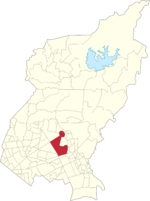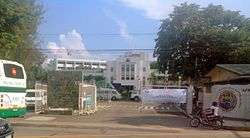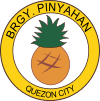Pinyahan
| Pinyahan | ||
|---|---|---|
| Barangay | ||
|
The AFP Medical Center in Pinyahan | ||
| ||
| Nickname(s): Piñahan | ||
 Map of Quezon City showing Barangay Pinyahan | ||
 Pinyahan Location of Barangay Pinyahan within Metro Manila | ||
| Coordinates: 14°38′24″N 121°2′46″E / 14.64000°N 121.04611°ECoordinates: 14°38′24″N 121°2′46″E / 14.64000°N 121.04611°E | ||
| Country | Philippines | |
| Region | National Capital Region | |
| City | Quezon City | |
| District | 4th District of Quezon City | |
| Established | June 25, 1975[1] | |
| Government | ||
| • Type | Barangay | |
| • Barangay Captain | Jesus N. Lipnica, Jr.[2] | |
| Population (2010) | ||
| • Total | 28,129[3] | |
| Time zone | PST (UTC+8) | |
| Postal Code | 1100 | |
| Area code(s) | 2 | |
Pinyahan, sometimes spelled Piñahan, is a barangay of Quezon City.
History
Barangay Pinyahan was previously part of Central District Diliman. Central District Diliman was divided into two separate entities, namely Barangay Central and Pinyahan.[4][5]
Etymology
Pinyahan means "a place where pineapple is grown" in Tagalog. Prior to its subdivision by the People's Homesite and Housing Corporation, the land which occupies present-day Pinyahan was a popular place for cultivating pineapples since the 1930s, thus the name of the barangay.[4]
Health
Several hospitals are based in Pinyahan including Lung Center of the Philippines, National Kidney and Transplant Institute (NKTI), Urology Center of the Philippines and the Armed Forces of the Philippines Medical Center along V. Luna Avenue.
Education
Pinyahan Elementary School[6] and Flora Ylagan High School are public schools based in Pinyahan. The AFP Medical Service School, is loacated within the Armed Forces of the Philippines Medical Center.[7]
Culture
The barangay celebrates its fiesta every May 15. The barangay patron saint is San Isidro Labrador.[1]
References
- 1 2 "Quezonian Newsletter - Barangay Profiles - Pinyahan". Quezon City Public Library. Retrieved 25 September 2014.
- ↑ "Quezon City Barangays". Local Government of Quezon City. Retrieved 4 January 2014.
- ↑ "Quezon City Population Peaked at 2.8 Million (Results from the 2010 Census of Population and Housing)". National Statistics Office. 26 July 2013. Retrieved 4 January 2014.
- 1 2 Quezon City Public Library - Quezonian Newsletter
- ↑ "History of Quezon City Barangays". Quezonian Newsletter. Quezon City Public Library. Chapter 15 History of Quezon City Barangays. Retrieved 23 February 2015.
On June 22, 1963, RA 3590 known as the Revised Barrio Charter amending RA 2370 was enacted expanding the scope of the barrio power. Membership in the council was increased to include a barrio executive as Barrio Captain and six councilmen and granting powers to the barrio officials. Barangay Pinyahan has been originally a part of Central District Diliman and Central District was divided into two which became Barangay Central and Pinyahan. The area of Pinyahan has been popularly known as a place for growing abundant pineapples since the early 1930s until it was subdivided in 1948 by the PHHC.
- ↑ "Elementary Schools District IV". Division of City Schools Quezon City. Retrieved 1 May 2015.
- ↑ "AFP Medical Service School". Armed Forces of the Philippines Medical Center. Retrieved 1 May 2015.

